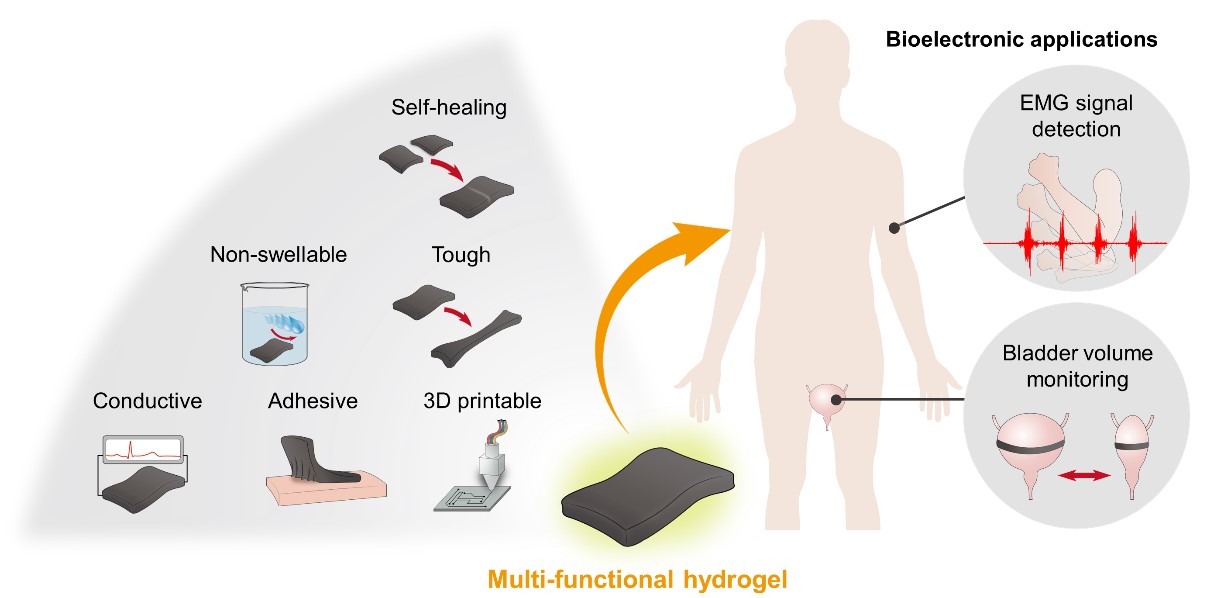New Multifunctional Hydrogel for Tissue-Adaptable Bioelectronics
Researchers design a novel hydrogel that is soft yet tough, self-healing, non-swellable, conductive, and ideal for 3D printing bioelectric devices
Research published online in Advanced Science in February 2023

Caption: Researchers present a non-swellable, multifunctional, and 3D-printable hydrogel that could improve the robustness of bioelectronics.
Photo Credits: Advanced Science
The healthcare industry is on the lookout for technologies that can enable professionals to monitor patient health even in remote settings. Recent advances in bioelectronics are focusing on the development of smart devices that can retain long-term functionality inside the human body. Unfortunately, most bioelectronic devices in current use often suffer from a lack of tissue adaptability, since they tend to be stiff while the biological tissues are soft.
Recently, hydrogels have gained attention as a promising material for enabling effective interfacing of bioelectronics with biological tissue surfaces. However, they are often mechanically weak, lack adequate electrical properties, and are prone to swelling and deterioration in the presence of water. Since tissues in the human body are usually in water-rich environments, hydrogels that can withstand water and provide long-term functionality must be designed.
With this goal, a group of researchers, led by Associate Professor Jungmok Seo from Yonsei University, Korea, has recently developed a novel hydrogel that is soft and stretchable yet tough, non-swellable, 3D-printable, and self-healing. It comprises tannic acid (TA), hydrophilic polymers such as poly(acrylic acid) (PAA) and poly(vinyl alcohol) (PVA), and functionalized carbon nanotubes (fCNT)—carbon nanotubes functionalized with carboxyl and hydroxyl groups. The hydrophobic benzene groups of TA and fCNT promote nanophase separation against the hydrophilic polymers through hydrophobic interaction and π-stacking, forming a nanoconfinement network within the hydrogel.
“This unique structure of the hydrogel is inspired from the structure of silk found in nature, which exhibits softness alongside high toughness. Although silk primarily consists of weak bonds, its nanoconfinement structure enables it to possess high toughness,” says Dr. Seo on the motivation behind the present research, which was published in Advanced Science on 17 February 2023.
Unlike conventional TA-based hydrogels, the new fCNT/TA/PVA/PAA hydrogel was able to overcome several trade-offs among several properties owing to its novel dynamic nanoconfinement network structure. The nanoconfinement not only ensured high conductivity and softness alongside toughness but also triggered rapid healing within five minutes of damage. In addition, a simple chemical modification enabled tissue-adhesiveness, improving the bio-interfacing of the hydrogel. Moreover, the hydrogel could be 3D-printed with high resolution for fabricating bioelectronic devices.
The researchers successfully demonstrated the practical potential of their hydrogel by using it for ex vivo bladder expansion monitoring and underwater electromyography detection. They envision that the multifunctional hydrogel will bridge the gap between bioelectronic devices and humans. “It can help us design robust tissue-adaptable bioelectronics that can provide precise and remote healthcare to people, especially to the elderly for whom regular hospital visits can be pretty taxing,” speculates Dr. Seo.
In conclusion, bioelectronics based on the fCNT/TA/PVA/PAA hydrogel could be the key to solving medical issues accompanied by global aging.
Recommended Articles
Professor Jong-Hyun Ahn
Novel technique for producing high-resolution micro-LED displays
Professor Seong Chan Jun
Professor Donghyun Kim
Array of hope: Up close and personal with mitochondria in neurons